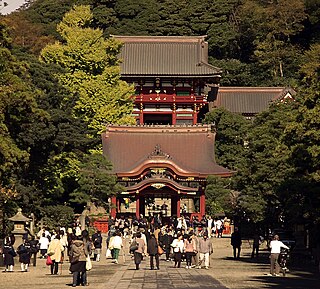
In Japanese religion, Yahata formerly in Shinto and later commonly known as Hachiman is the syncretic divinity of archery and war, incorporating elements from both Shinto and Buddhism.

Iwashimizu Hachimangū (石清水八幡宮) is a Shinto shrine in the city of Yawata in Kyoto Prefecture, Japan.

A Shinto shrine is a structure whose main purpose is to house ("enshrine") one or more kami, the deities of the Shinto religion.

Tsurugaoka Hachimangū (鶴岡八幡宮) is the most important Shinto shrine in the city of Kamakura, Kanagawa Prefecture, Japan. The shrine is a cultural center of the city of Kamakura and serves as the venue of many of its most important festivals with two museums.

A Hachiman shrine is a Shinto shrine dedicated to the kami Hachiman. It is the second most numerous type of Shinto shrine after those dedicated to Inari Ōkami. There are about 44,000 Hachiman shrines.

Usa Jingū (宇佐神宮), also known as Usa Hachimangū (宇佐八幡宮), is a Shinto shrine in the city of Usa in Ōita Prefecture in Japan. Emperor Ojin, who was deified as Hachiman-jin, is said to be enshrined in all the sites dedicated to him; and the first and earliest of these was at Usa in the early 8th century. The Usa Jingū has long been the recipient of Imperial patronage; and its prestige is considered second only to that of Ise.

Fujisaki Hachiman-gū (藤崎八幡宮) is a Shinto shrine located in Chūō-ku, Kumamoto, Kumamoto, Japan. It is dedicated to Emperor Ōjin, Empress Jingū and Sumiyoshi Sanjin.

Until the Meiji period (1868–1912), the jingū-ji were places of worship composed of a Buddhist temple and a Shinto shrine, both dedicated to a local kami. These complexes were born when a temple was erected next to a shrine to help its kami with its karmic problems. At the time, kami were thought to be also subjected to karma, and therefore in need of a salvation only Buddhism could provide. Having first appeared during the Nara period (710–794), jingū-ji remained common for over a millennium until, with few exceptions, they were destroyed in compliance with the Kami and Buddhas Separation Act of 1868. Seiganto-ji is a Tendai temple part of the Kumano Sanzan Shinto shrine complex, and as such can be considered one of the few shrine-temples still extant.

Morioka Hachimangū (盛岡八幡宮) is a Shinto shrine in the city of Morioka, Iwate in northern Japan. The shrine is noted for its annual festival on the second Saturday in June, which is famous for the Chagu Chagu Umakko, a horse parade which was recognized in 1978 as an Intangible Folk Cultural Property. In 1996 the sound of the bells of the Chagu Chagu Umakko was selected by the Ministry of the Environment as one of the 100 Soundscapes of Japan. The shrine is also noted for its displays of yabusame horse archery during its annual festival on September 15.

Tamukeyama Hachiman Shrine is a Shinto shrine near Tōdai-ji, Nara, Nara Prefecture, Japan. It is a Hachiman shrine, dedicated to the kami Hachiman. It was established in 749. Kami enshrined here include Emperor Ojin, Emperor Nintoku, Empress Jingū and Emperor Chūai in addition to Hachiman.

Ōmiya Hachiman Shrine is a Shinto shrine located in Suginami, Tokyo, Japan. It is a Hachiman shrine, dedicated to the kami Hachiman. It was established in 1063. Its main festival is held annually on September 15. Kami enshrined here include Emperor Ōjin, Empress Jingū and Emperor Chūai in addition to Hachiman.

Chiriku Hachiman Shrine is a Shinto shrine in the Shirakabe neighborhood of the town of Miyaki in Saga Prefecture, Japan. It is one of the shrines claiming to be the ichinomiya of former Hizen Province. The main festival of the shrine is held annually on March 15.

Himure Hachiman-gū (日牟禮八幡宮) is a Shinto shrine located in the city of Ōmihachiman, Shiga Prefecture, Japan. The city is named after this shrine, and it is located within the Omihachiman City Traditional Buildings Preservation Area. The shrine has two main festivals, the Sagichō Matsuri (左義長まつり) and the Hachiman Matsuri (八幡まつり) which are both designated National Intangible Folk Cultural Properties.

Sapporo Hachimangū is a Shinto shrine located in Sapporo, Hokkaido. It is a Hachiman shrine, dedicated to the kami Hachiman. It was established in 1977. Kami enshrined here include Tenjin (天満大神), Sugawara no Michizane), Akibadai Gongen (秋葉大権現), Ume no Miya Okami (梅の宮大神), and Kotohira no Okami (金刀比羅大神).

Tsuboi Hachimangū is a Shinto shrine located in Habikino, Osaka Prefecture, Japan. It is a Hachiman shrine, dedicated to the kami Hachiman. It was established in 1064. Its main festival is held annually on May 15.

Kushihiki Hachimangū is a Shinto shrine located in Hachinohe, Aomori Prefecture, Japan. It is a Hachiman shrine, dedicated to the kami Hachiman. It was established c. 1190-1199. Its main festivals are held annually on April 15 and August 15 according to the lunar calendar, and on May 14. In the former Modern system of ranked Shinto shrines, it was classified as a district shrine.
Torigoe Hachiman Shrine is a Shinto shrine located in Shinjō, Yamagata Prefecture, Japan. It is a Hachiman shrine, dedicated to the kami Hachiman. The shrine was founded in 1229, and its annual festival is on August 15.
Iino Hachimangū is a Shinto shrine located in Iwaki, Fukushima Prefecture, Japan. It is a Hachiman shrine, dedicated to the kami Hachiman. The shrine was founded in either 1063 or 1186, and its annual festival is on September 14. The kami it enshrines include Emperor Ōjin as Hondawake no mikoto (品陀別命), Empress Jingū as Okinagatarashihime no Mikoto (息長帯姫命), and Himegami (比売神).
Kameyama Hachimangū is a Shinto shrine located in Shimonoseki, Yamaguchi Prefecture, Japan. It is a Hachiman shrine, dedicated to the kami Hachiman. The kami enshrined there include Emperor Ōjin, Empress Jingū, and Emperor Chūai. It was established in 859, and has an annual festival on October 15.

















